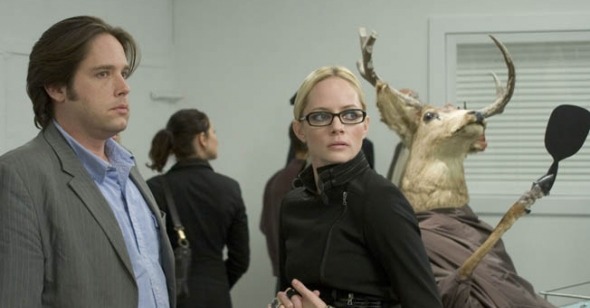Art Attack
by Michael Joshua Rowin
(Untitled)
Dir. Jonathan Parker, U.S., Samuel Goldwyn
Jonathan Parker’s high art send-up (Untitled) practically begs crippling questions about its own existence: for instance, to whom is such a film supposed to appeal? A pretentious Manhattan art scene of cynical gallery owners and inflated avant-garde sculptors isn’t material ripe for popular satire, and the few connoisseurs of the beaux arts with whom the film might connect will likely be put off by its irreverent tone—this is a milieu not exactly known for its self-deprecating humor. Its potential audience in doubt and its prime target an old, tattered stand-by (Woody Allen, among others, has been skewering highfalutin artistes for four decades now), (Untitled) can thus only offer intermittently funny pokes at its subject while its larger purpose, or point, remains unclear.
Written by Parker and Catherine di Napoli, (Untitled) stars Adam Goldberg as Adrian Jacobs and Eion Bailey as his brother Josh, the former a morose and struggling avant-garde composer and pianist, the latter a middling and financially more successful painter whose drearily mediocre abstracts sell quite well on the hotel lobby and hospital waiting-room market. A woman, naturally, comes between them: Josh’s dealer, Madeleine (Marley Shelton), is a cold, skin-tight leather-wearing Sarah Lawrence graduate unenthusiastic about dating the handsome but delusional artist, and quickly takes more to Adrian’s sour, pretentious, and uncompromising sonic outlaw.
In the artistic and romantic contest between the two brothers, issues arise about what constitutes art and why extremes permissible (and salable) in one medium are not in another. While Madeleine stays in the black via Josh’s mediocrity, her gallery’s prestige rests on the moronic shock art of Ray Barko (Vinnie Jones), a British sculptor who poses taxidermic animals within violent tableaux, e.g. a lamb dressed as a child falling off a bicycle. Barko is hot in his respective scene, which leads Josh to demand his own show, but Adrian’s equally abrasive and ludicrous work goes virtually unnoticed. Performed by a monochrome-attired group of fellow “serious” musicians, his pieces involve screeching, tearing newspapers, kazoos, and chains dropped into buckets. Why such unlistenable brutality? “Entertainment doesn’t pose problems it can’t solve,” Adrian angrily explains. “Harmony is a capitalist conspiracy to sell pianos.”
Such dialogue makes (Untitled) enjoyable, if not scathingly so. A gallery assistant intrigues a collector using critical gibberish, describing a minimalist artist’s aesthetic as “a superficial banality that’s both sexual and imposing”; Barko storms into a space showing his art, insists on a complete rearrangement, and then just as capriciously asks it to be left alone; ultimately, most of the descriptive and artistic atrocities on display in the film can be responded to by Adrian’s wry musing: “Sometimes it’s so personal you should keep it to yourself.” Though Park and di Napoli’s jokes remain at the level of zingy bon mots and their characters are mere caricatures (a comedic m.o. in evidence in their unneeded sitcom-y update of Melville’s Bartleby), the cartoonishness of the insular imagined demi-monde fits the shallowness of the art world players they mock. Funniest of all is the gullible collector Porter (Zak Orth), indiscriminately purchasing the ugliest art imaginable as a financial investment in the hope of contributing to the history of western civilization with his wallet. Wearing a hip-hop-style track suit and a cassette tape necklace, Porter shamelessly admits to not knowing Matisse while proudly flaunting his prized possessions: mannequins sprouting dildos from their foreheads and a life-sized projected loop of himself in his bathroom.
Good gags, these, but (Untitled) is far less incisive about art world institutions, about how money and politics play a role in promoting and maintaining certain artists, styles, and “schools” rather than others. One subplot has Barko signing with a bigger gallery that promises him better exposure; he soon falls into ruin when the price of his art is set too high. This is all explained in less than a minute of screen time just to set up the obvious punchline: Barko snuffs it in an accident involving his own sculpture (a cow chandelier), which leads to the exploitation of his death for publicity purposes. The otherwise spot-on Art School Confidential also disappointingly ended with a lesson about infamy currently offering the only road to distinction and notice, but aside from being a clichéd scenario with few real-life parallels—the pathetically untalented Dash Snow notwithstanding—Barko’s story is all the more unsatisfactory for preventing a look into how actual good art is made within the system (Untitled) derides.
It’s easy to laugh at the art world and its vain and greedy characters when the resulting art is bad; but when the art is actually of merit complex and difficult relationships arise between opportunistic creators and their worthy creations. Parker and di Napoli attempt to account for quality by having Adrian, sick of the phoniness fueling his and others’ “difficult” art, find inspiration when he literally rids himself of his bells and whistles and writes a “beautiful” composition on piano—American Beauty¬–style, a plastic bag clinging to a tree suddenly flies away at the moment of Adrian’s creative revelation. It’s an unconvincing scenario, and when Adrian’s struggle is ironically appreciated by another obscure composer (working as a waiter) we realize (Untitled) has undeniably sacrificed an honest look at the artistic experience for the comforts of broad-side-of-barn parody.
